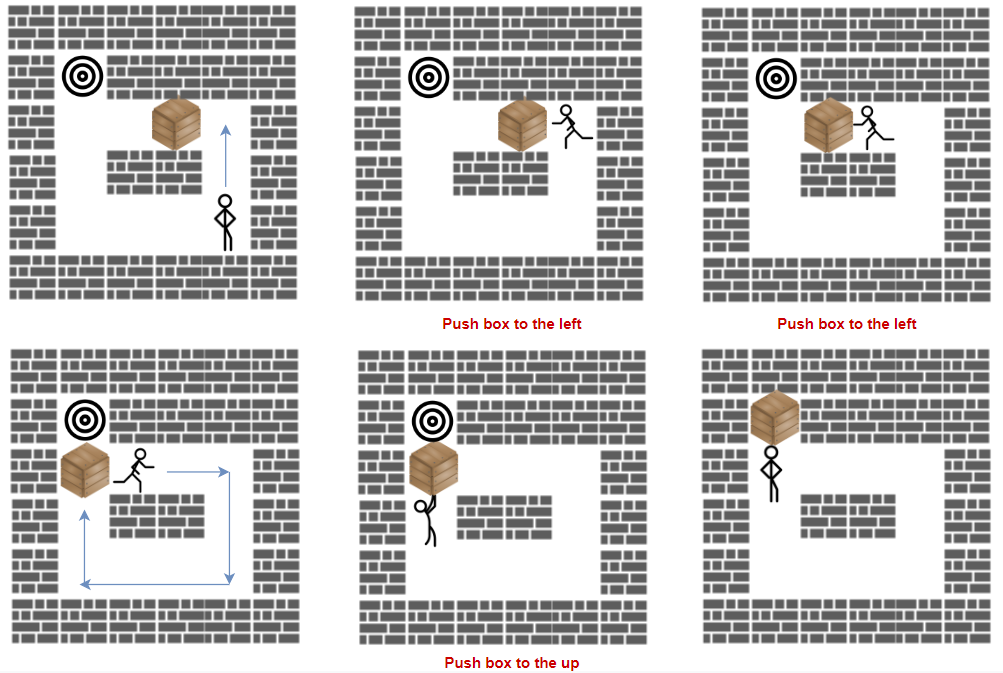原文链接: https://leetcode-cn.com/problems/minimum-moves-to-move-a-box-to-their-target-location
英文原文
A storekeeper is a game in which the player pushes boxes around in a warehouse trying to get them to target locations.
The game is represented by an m x n grid of characters grid where each element is a wall, floor, or box.
Your task is to move the box 'B' to the target position 'T' under the following rules:
- The character
'S'represents the player. The player can move up, down, left, right ingridif it is a floor (empty cell). - The character
'.'represents the floor which means a free cell to walk. - The character
'#'represents the wall which means an obstacle (impossible to walk there). - There is only one box
'B'and one target cell'T'in thegrid. - The box can be moved to an adjacent free cell by standing next to the box and then moving in the direction of the box. This is a push.
- The player cannot walk through the box.
Return the minimum number of pushes to move the box to the target. If there is no way to reach the target, return -1.
Example 1:

Input: grid = [["#","#","#","#","#","#"],
["#","T","#","#","#","#"],
["#",".",".","B",".","#"],
["#",".","#","#",".","#"],
["#",".",".",".","S","#"],
["#","#","#","#","#","#"]]
Output: 3
Explanation: We return only the number of times the box is pushed.
Example 2:
Input: grid = [["#","#","#","#","#","#"],
["#","T","#","#","#","#"],
["#",".",".","B",".","#"],
["#","#","#","#",".","#"],
["#",".",".",".","S","#"],
["#","#","#","#","#","#"]]
Output: -1
Example 3:
Input: grid = [["#","#","#","#","#","#"], ["#","T",".",".","#","#"], ["#",".","#","B",".","#"], ["#",".",".",".",".","#"], ["#",".",".",".","S","#"], ["#","#","#","#","#","#"]] Output: 5 Explanation: push the box down, left, left, up and up.
Example 4:
Input: grid = [["#","#","#","#","#","#","#"], ["#","S","#",".","B","T","#"], ["#","#","#","#","#","#","#"]] Output: -1
Constraints:
m == grid.lengthn == grid[i].length1 <= m, n <= 20gridcontains only characters'.','#','S','T', or'B'.- There is only one character
'S','B', and'T'in thegrid.
中文题目
「推箱子」是一款风靡全球的益智小游戏,玩家需要将箱子推到仓库中的目标位置。
游戏地图用大小为 n * m 的网格 grid 表示,其中每个元素可以是墙、地板或者是箱子。
现在你将作为玩家参与游戏,按规则将箱子 'B' 移动到目标位置 'T' :
- 玩家用字符
'S'表示,只要他在地板上,就可以在网格中向上、下、左、右四个方向移动。 - 地板用字符
'.'表示,意味着可以自由行走。 - 墙用字符
'#'表示,意味着障碍物,不能通行。 - 箱子仅有一个,用字符
'B'表示。相应地,网格上有一个目标位置'T'。 - 玩家需要站在箱子旁边,然后沿着箱子的方向进行移动,此时箱子会被移动到相邻的地板单元格。记作一次「推动」。
- 玩家无法越过箱子。
返回将箱子推到目标位置的最小 推动 次数,如果无法做到,请返回 -1。
示例 1:

输入:grid = [["#","#","#","#","#","#"],
["#","T","#","#","#","#"],
["#",".",".","B",".","#"],
["#",".","#","#",".","#"],
["#",".",".",".","S","#"],
["#","#","#","#","#","#"]]
输出:3
解释:我们只需要返回推箱子的次数。
示例 2:
输入:grid = [["#","#","#","#","#","#"],
["#","T","#","#","#","#"],
["#",".",".","B",".","#"],
["#","#","#","#",".","#"],
["#",".",".",".","S","#"],
["#","#","#","#","#","#"]]
输出:-1
示例 3:
输入:grid = [["#","#","#","#","#","#"], ["#","T",".",".","#","#"], ["#",".","#","B",".","#"], ["#",".",".",".",".","#"], ["#",".",".",".","S","#"], ["#","#","#","#","#","#"]] 输出:5 解释:向下、向左、向左、向上再向上。
示例 4:
输入:grid = [["#","#","#","#","#","#","#"], ["#","S","#",".","B","T","#"], ["#","#","#","#","#","#","#"]] 输出:-1
提示:
1 <= grid.length <= 201 <= grid[i].length <= 20grid仅包含字符'.','#','S','T', 以及'B'。grid中'S','B'和'T'各只能出现一个。
通过代码
高赞题解
BFS:
- BFS 每走一步,会把下一步能走的格子加入队列
- 按顺序走完这一步所有的可能,队列里就剩下下一步所有的可能
- 当走到终点时,就是最少步骤
- 每走一步,还会使用 set 来记录已经走到过的格子的坐标
- 把下一步加入队列前,检查,重复的就不用进队列了
分析:
- 如果这道题没有人,箱子自己走,那么只需要了解BFS,就可以解决了
- 如果有人存在,把人的状态同时记录下来
- 当人走到箱子的格子上,把箱子沿同一方向移动,如果箱子位置合法,那就是推动箱子了
问题和解决:
同时记录人和箱子的状态,会有一些问题要解决
- 因为人也动,箱子也动,但是只有箱子动才算步数,所以加入队列的顺序,并不是步数顺序了
所以需要一个记录步数,同时记录人和箱子的坐标,还可以排序的队列
使用 priority_queue(优先队列)解决。
队列中的数据是[]priority_queue<vector<size_t>, vector<vector<size_t>>, greater<vector<size_t>>> pq;vector<size_t>
优先队列会使用vector<vector<size_t>>来保存vector<size_t>
设置为升序存储greater<vector<size_t>>其中
vector<size_t>保存的内容是:
[0] 当前状态最小推箱子次数
[1] 人的坐标 x
[2] 人的坐标 y
[3] 箱子的坐标 x
[4] 箱子的坐标 y - set 怎么调整
set<vector<size_t>>用人和箱子的坐标来做记录[0] 人的坐标 x
[1] 人的坐标 y
[2] 箱子的坐标 x
[3] 箱子的坐标 y
解题思路:
- 定义优先队列
- 将原始数据中的人和箱子坐标提取出来,地图还原成通路
- 将起始状态存入队列
- 定义 set
- 将起始状态存入 set
- 定义方向数组
- 开始 bfs 吧,
while (!pq.empty()) - 对人移动,检查合法性
- 检查人是否走到箱子上
- 移动箱子,检查合法性
- 步数 +1
- 判断箱子是否到终点,返回步数
- 检查 set,移动后是否重复,记录 set
- 如果 bfs 没结果,无法到达终点,返回 -1
模拟:
< ,
, ,
, ,
, ,
, >
>
做了几张图帮助理解一下,虽然只有开始的几步,但是如果理解了,后面脑补就可以了。
可以看到,当从队列中取出一个状态,4 种情况有一种情况是推动箱子,另一种是箱子没动人动。
当 4 种情况中合理的都加入队列后,根据优先队列的排序,下一个状态是优先箱子没动人动的情况。
因为题目的最终目的是求最少的箱子移动步数,所以只要箱子没动,步数都不增加,那么优先级就会高
所以 bfs 才能按照步数作为参考
答题
[]int minPushBox(vector<vector<char>>& grid) { // pq,[0]当前状态最小推箱子次数 [1]人的坐标x [2]人的坐标y [3]箱子的坐标x [4]箱子的坐标y priority_queue<vector<size_t>, vector<vector<size_t>>, greater<vector<size_t>>> pq; size_t m = grid.size(); size_t n = grid[0].size(); vector<size_t> a(5, 0); for (size_t x = 0; x < m; x++) { for (size_t y = 0; y < n; y++) { if (grid[x][y] == 'S') { a[1] = x; a[2] = y; grid[x][y] = '.'; } else if (grid[x][y] == 'B') { a[3] = x; a[4] = y; grid[x][y] = '.'; } } } pq.push(a); set<vector<size_t>> dist; dist.insert({ a[1], a[2], a[3], a[4] }); int dx[4] = { 0,0,1,-1 }; int dy[4] = { 1,-1,0,0 }; while (!pq.empty()) { auto v = pq.top(); pq.pop(); for (int i = 0; i < 4; i++) { vector<size_t> next_s = { v[1] + dx[i], v[2] + dy[i] }; if (next_s[0] >= m || next_s[1] >= n || grid[next_s[0]][next_s[1]] == '#') { continue; } vector<size_t> next_b = { v[3], v[4] }; size_t d = v[0]; if (next_s == next_b) { next_b[0] += dx[i]; next_b[1] += dy[i]; if (next_b[0] >= m || next_b[1] >= n || grid[next_b[0]][next_b[1]] == '#') { continue; } d++; } if (grid[next_b[0]][next_b[1]] == 'T') { return (int)d; } if (dist.find({next_s[0], next_s[1], next_b[0], next_b[1]}) != dist.end()) { continue; } dist.insert({ next_s[0], next_s[1], next_b[0], next_b[1] }); pq.push({ d, next_s[0], next_s[1], next_b[0], next_b[1] }); } } return -1; }
致谢:
感谢 小白二号 @scut_dell 的竞赛题解,让我学到了这种解法。
我学会之后,再详细的讲解,分享给他人。
感谢您的观看,希望对您有帮助,欢迎热烈的交流!
统计信息
| 通过次数 | 提交次数 | AC比率 |
|---|---|---|
| 3453 | 8047 | 42.9% |
提交历史
| 提交时间 | 提交结果 | 执行时间 | 内存消耗 | 语言 |
|---|



